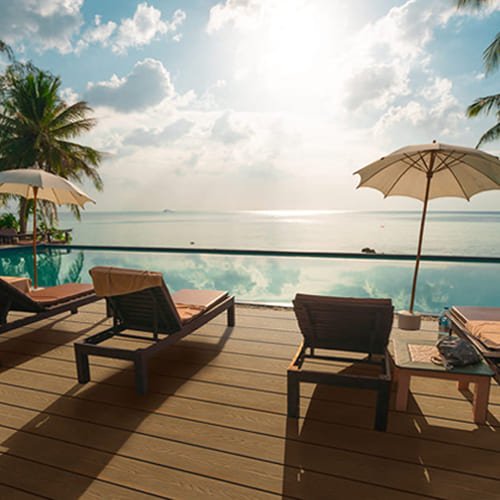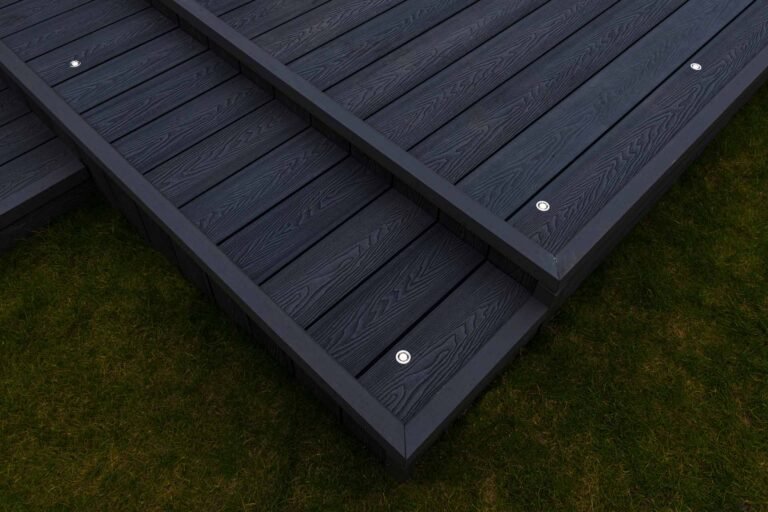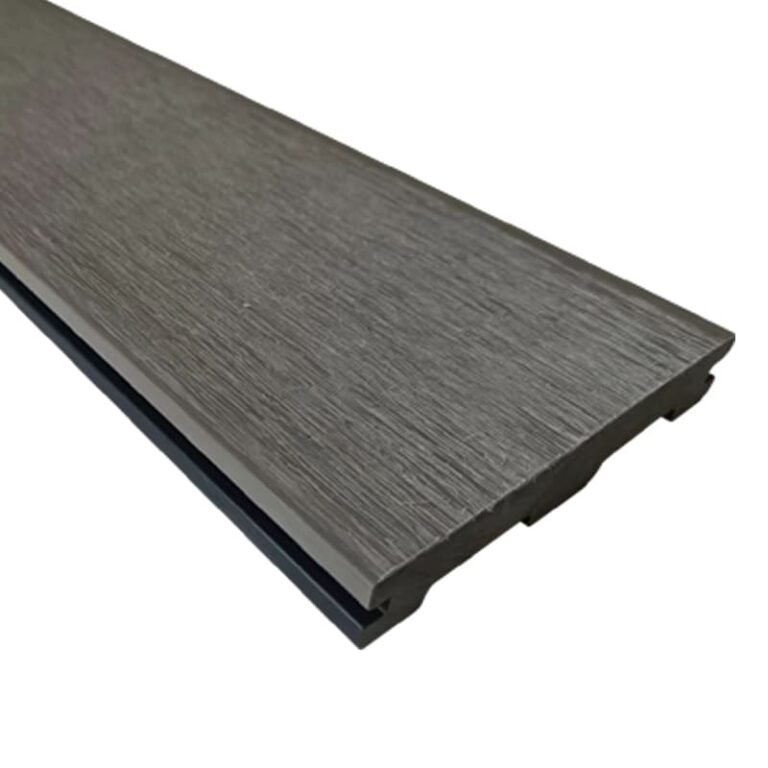Are you worried that a new composite deck will look washed out after a few seasons? This fear can stop you from choosing a great material. Understanding how fading works helps you pick the right product.
Yes, all composite decking fades to some extent when exposed to sunlight. Most of this fading happens in the first 3 to 5 months after installation. After this initial period, the color stabilizes, and any further fading is usually minimal and very difficult to notice.
I get this question all the time from my partners. It’s a valid concern because color is a huge part of a project's appeal. In my 12+ years in the WPC industry, I've seen how important it is to be clear about this. You don't want your customers to have the wrong expectations. So, let's break down exactly what happens and what you can do about it. The key is knowing what you are buying. Let's look at the specifics so you can give your customers the right information and build trust.
How much will composite decking fade?
You need to tell your customers what to expect. Saying it will "fade a little" is too vague. Unpredictable color changes[^1] can damage your reputation as a supplier who knows their products.
Composite decking typically loses a few shades of its original color. Most of this change happens in the first 3 to 5 months. After that, the color becomes very stable. The amount of fading depends on the product type—capped composite fades much less than uncapped composite decking[^2].
From my experience, being upfront about fading builds more trust than pretending it doesn't happen. The key is to explain the process and the difference between product types. This shows you're an expert and helps your clients make an informed choice they'll be happy with for years to come.
The Initial Weathering Stage
The fading you see in the first few months is a natural part of the material settling in. Composite decking contains wood fibers, and it's the lignin in these fibers that reacts to UV sunlight. This initial period is when the deck weathers and reaches its long-term, stable color. Once this phase is over, any further changes are so slow and minor that you can barely see them. It's important to set this expectation with customers so they aren't surprised by the initial change.
Product Type Matters a Lot
The biggest factor in how much a deck will fade is the type of board you choose. There's a huge difference between traditional composites[^3] and modern co-extrusion[^4] (or capped) composites.
| Feature | Traditional (Classic) WPC | Co-extrusion (Capped) WPC |
|---|---|---|
| Fading Amount | Noticeable in first 3-5 months | Minimal, almost unnoticeable |
| Color Stability | Stabilizes after initial period | Highly stable from day one |
| Reason | Exposed wood fibers fade in UV light | Protective polymer cap[^5] shields core |
I always tell my partners to position co-extrusion decking as the premium solution for color stability. It's a clear selling point for customers who prioritize long-lasting aesthetics.
How to stop composite decking fading?
Your customers want a deck that looks new for years. They might ask if fading can be completely prevented. Telling them no without offering a solution can make your product seem weak.
You cannot completely stop any outdoor material from fading under the sun. However, you can choose a product with superior fade resistance. Co-extrusion, or "capped," composite decking is the best option. Its protective outer layer is engineered to resist UV degradation[^6] and maintain its color for much longer.
I always use a simple analogy when talking to my partners. Think about a car's paint, outdoor furniture, or even a simple plastic bucket left in the yard. If it's outside in the sun, its color will change over time. It's a basic law of physics. Our job isn't to promise the impossible, but to provide the best possible solution based on modern technology.
Why Nothing is Truly "Fade-Proof"
The sun’s ultraviolet (UV) rays are powerful. They break down the chemical bonds in pigments and materials, which causes colors to fade. This process affects everything, from natural wood to plastics and fabrics. So, when a customer asks for something "fade-proof," it's an opportunity to educate them. No reputable manufacturer can make that claim. But we can claim "fade-resistant[^7]," and that is a promise we can stand behind.
The Engineering Solution: Co-Extrusion Decking
The development of co-extrusion technology was a game-changer for the WPC industry, especially for color performance. We created these products specifically to address the demand for better fade resistance. The standard composite core is capped with a protective polymer shield. This outer layer is non-porous and contains no wood fibers. More importantly, we pack this cap with extra UV inhibitors and high-quality color pigments. This shield takes the full force of the sun, protecting the board's core and, most importantly, its color. For any distributor whose customers are worried about fading, co-extrusion is the clear answer.
Can faded composite decking be restored?
A customer has a faded deck. They ask if you can bring back the original, vibrant color. Giving the wrong advice could lead to a damaged deck and an unhappy end-user.
Unfortunately, the color fading in composite decking is irreversible. The UV rays change the material itself, not just a surface layer. You cannot restore the original color once it has faded. The key is prevention by choosing a fade-resistant product from the beginning.
This can be a tough message to deliver, but honesty is always the best policy. It protects your reputation as a knowledgeable supplier. I always stress this point to new partners: the most important decisions are made before the deck is even installed. Being clear about this from the start prevents future disappointment for everyone involved.
Understanding the Fading Process
With composite decking, fading isn't something sitting on the surface that you can wash or scrub off. The change happens within the material itself. The sun's UV rays penetrate the surface and break down the lignin in the wood fibers. This is a permanent chemical change. It's very different from traditional wood, which you can sand down to reveal a fresh layer underneath and then re-stain. But that process is exactly the kind of heavy maintenance that WPC was designed to eliminate. The trade-off for low maintenance is that the color, once weathered, is permanent.
The Importance of the Initial Purchase Decision
This brings us to the most critical point. The long-term appearance of a deck is determined on the day of purchase. As a distributor, this is your opportunity to guide your client correctly. I always coach my partners to have a direct conversation about expectations. Ask the customer, "How important is color stability to you over the next 10-15 years?" If it's a top priority, guiding them towards a co-extrusion product is the responsible thing to do. It might be a higher initial investment, but it delivers on the promise of long-lasting color and leads to greater customer satisfaction in the end.
Can you paint composite decking?
Your customers see painting as an easy fix for a faded deck or if they just want a new color. But this can create a huge headache and more maintenance than they ever wanted.
While you can technically paint composite decking, I strongly advise against it. The paint often doesn't adhere well to the plastic components and can peel or chip. This creates a new, ongoing maintenance problem that defeats the purpose of choosing low-maintenance composite decking.
Over my career, I've seen a few attempts to paint composite decks. The results are never good in the long run. At first, it might look fine, but soon the problems start. I make it very clear to my partners: recommending paint is bad advice. It undermines the core benefit of the product you are selling. You are selling freedom from maintenance, not introducing a new chore.
Why Paint Creates More Problems
The mix of wood and plastic in composite decking makes it a very difficult surface for paint. The plastic expands and contracts with temperature changes at a different rate than paint, which causes cracking and peeling. Also, because most composites are designed to be water-resistant, they don't have the porous surface that paint needs to grab onto. This poor adhesion means the beautiful new finish will soon start to flake off, especially in high-traffic areas. I also remind every distributor that applying paint, stains, or sealers to composite decking will almost always void the manufacturer's warranty.
Remember the Low-Maintenance Advantage
Let's go back to basics. Why do people choose WPC? They want to avoid the annual work of sanding, staining, and painting that timber requires. We designed WPC to be stable and resistant to rot, decay, and insects without any extra coatings. Real wood needs paint for protection. Composite decking does not. It is a sealed, finished product. By adding paint, you are re-introducing a maintenance cycle. You're creating the very problem that the customer paid to avoid. Always sell the benefit of low maintenance, and don't suggest a "fix" that cancels it out.
Conclusion
Fading is natural for any outdoor product, but it is completely manageable. Your product choice is the most important factor, with co-extrusion offering superior color stability. Always avoid painting to protect the deck's low-maintenance advantage.
---
[^1]: Understand the factors that lead to color changes in composite decking over time.
[^2]: Understand the benefits of capped composite decking and why it's a premium choice.
[^3]: Learn about traditional composite materials and how they compare to modern options.
[^4]: Discover how co-extrusion technology enhances fade resistance and color stability in composite decking.
[^5]: Learn how the polymer cap protects composite decking from fading and damage.
[^6]: Explore the impact of UV rays on composite materials and how to choose products that resist fading.
[^7]: Find out what features contribute to fade resistance in composite decking materials.








